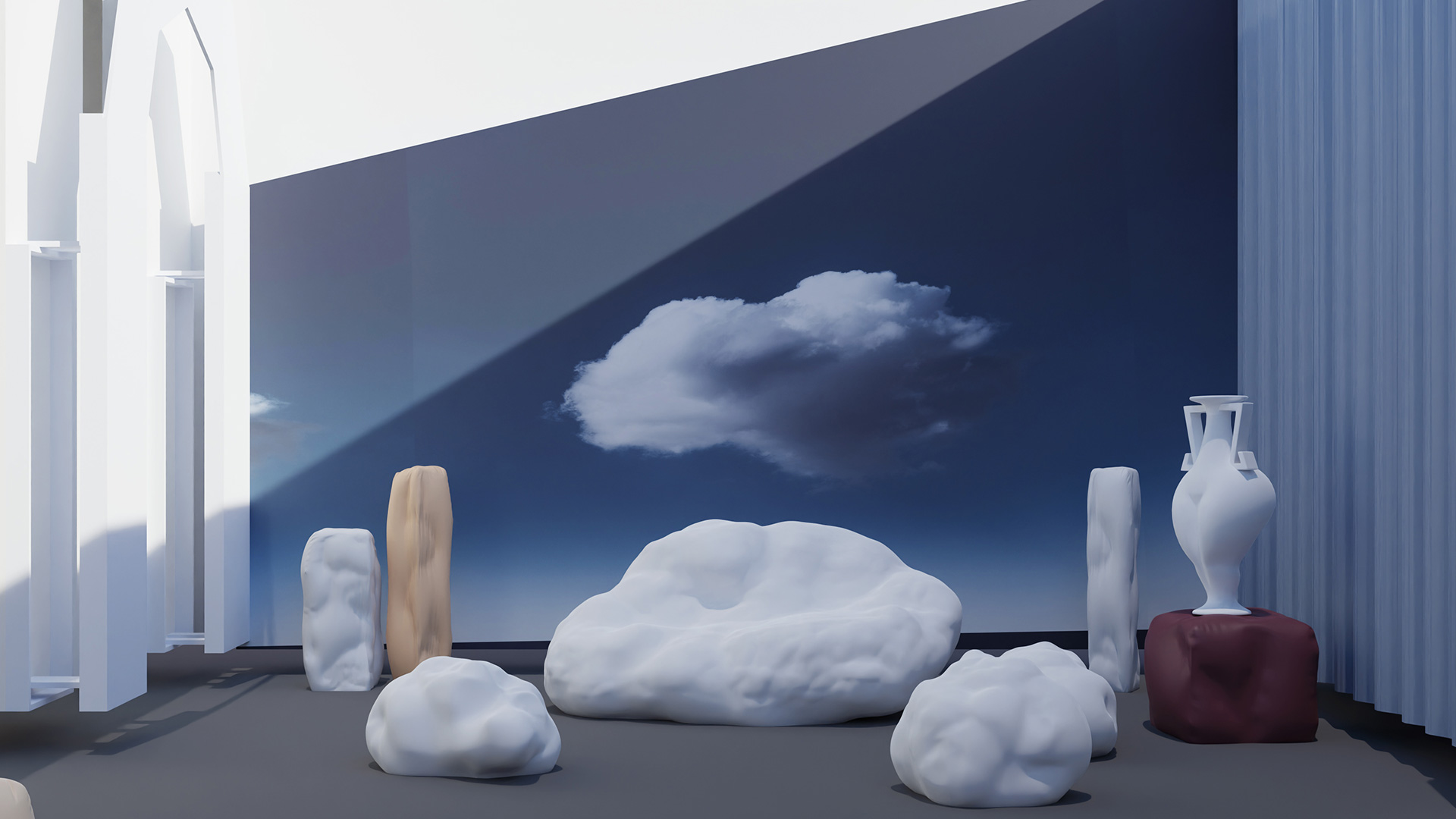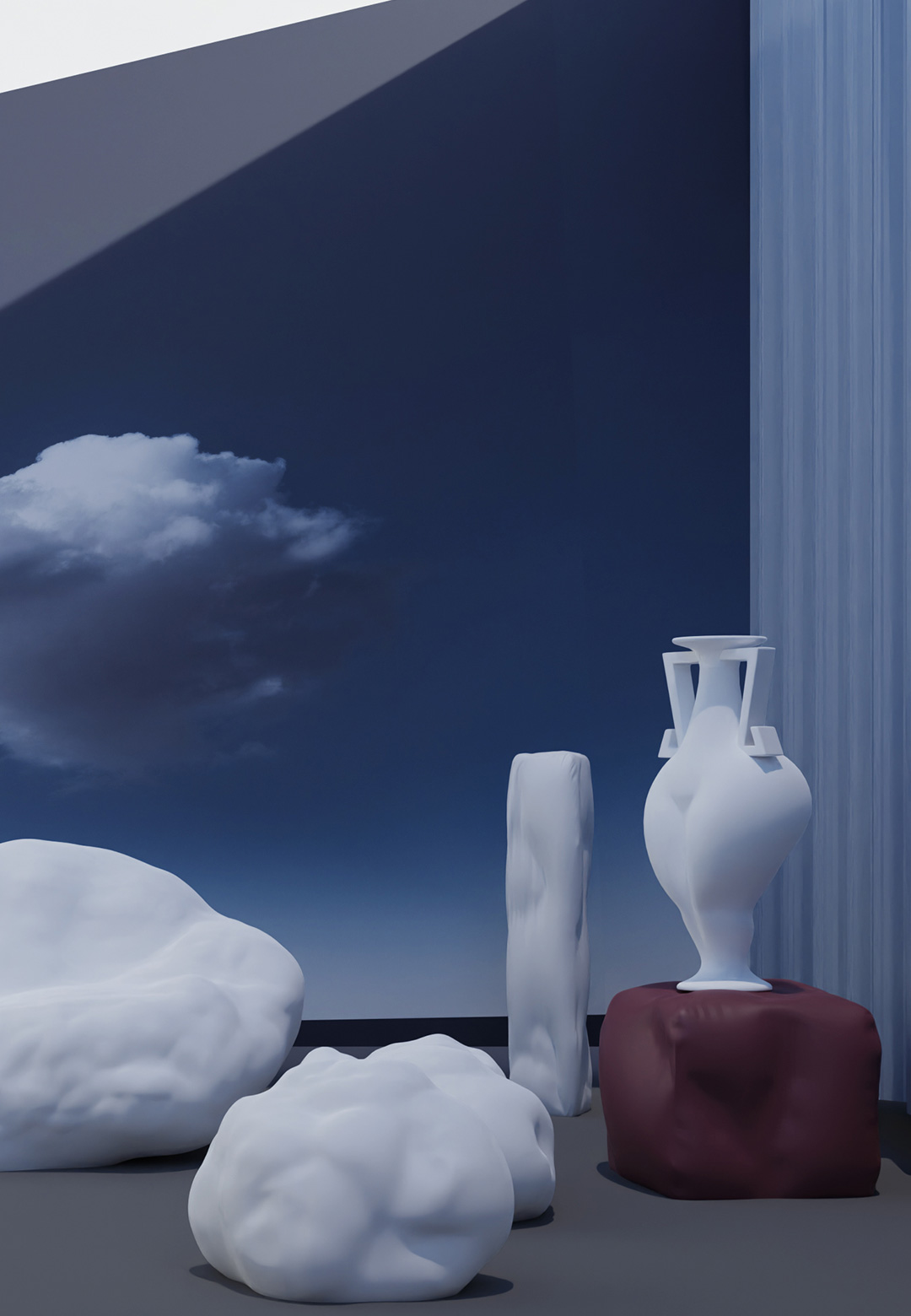The latest edition of Isola Design Festival, currently on view in the Isola Design District in Milan, Italy, comprises a showcase of unique handcrafted collectibles and utilitarian objects. Arranged in a space that evokes a metaphysical aura, the exhibition—organised by Isola Design Gallery—at Milan Design Week 2023 is the fourth iteration of this exposition that presents unique handmade objects by independent designers and design studios from across the globe. Works on display include objects and collectibles inspired by myriad ideas from the realms of art, architecture, design, and other adjacent disciplines. While the exhibition is designed as a surreal space, objects displayed as part of the showcase are experimental, both in the technique used to build them and the narratives explored through them. An excerpt from the exhibition text reads, “The exhibition will feel like a painting of Giorgio de Chirico thanks to the collaboration between Isola’s creative director, Elif Resitoglu and IAMMI’s co-founder, Stephanie Blanchard, who is providing handmade bases and pedestals cast in ‘gesso’ that are sculptural and collectible pieces themselves.”
With a total of 60 participants that hail from Argentina, Austria, Belgium, Brazil, Finland, France, Georgia, Germany, Italy, Japan, Lebanon, Mexico, the Netherlands, New Zealand, Peru, Russia, Slovenia, South Korea, Sweden, Switzerland, Taiwan, Turkey, United Kingdom and United States, Isola Design Gallery aims to celebrate a wide range of designs by creatives from multidisciplinary fields and heritages. “The exhibition will host works that focus on; collectible design that tells a story, customisable pieces that grant an experience, and contemporary products inspired by various areas of life,” the gallery shares in an official release.
Isola Design Gallery is the world’s first physical and digital platform pivoted on the task of giving visibility to independent designers and connecting them with curators, journalists, companies, design professionals, and potential clients and collaborators. The gallery selects projects that ponder on sustainability, are handcrafted, and aim to innovate and experiment.
From among the wide range of product and furniture designs showcased at the design exhibition, STIR curates a list of ten that stood out for us—with their stories, their mien, and the techniques applied to create them.
Futurity Lorels by Atelier Mlou
Futurity Lorels is an installation, a textile art mural, by Dutch designer Malou Beemer of Atelier Mlou, which comprises lorels—handmade islands of pleated fabric. Each lorel is distinct in shape. The folds administered to set them in place are unique and distinct from the adjacent lorel, too. Beemer’s Futurity Lorels allows for these lorels to be moved around on the canvas to create different compositions. Alternatively, they can be removed from the canvas and placed elsewhere in an interior space or even worn as part of an outfit. Beemer’s creation, hence, sits at the intersection of wearable design and collectible design. It also urges one to rethink the way wearable objects are typically designed, to be disposed of after reaching the end of their usability as a clothing object. Beemer aims to change this narrative with Futurity Lorels, a creation that can alternate between functioning as a fashion accessory, a collectible object and an interactive artwork.
Estero by Aura Carpio
Estero is a wall installation by Mexican industrial designer Aura Carpio. Handcrafted by expert artisans from the community of Santa Clara del Cobre in Michoacán, a state located in western Mexico, the installation is made out of a copper sheet and carved green stone. The decorative piece appears like a block of raw copper, its texture a result of smelting copper scraps. Tools such as wooden sticks, different types of hammers, and the human hand shape Estero. This technique of heating and hitting to create the installation not only helps reduce waste but also improves the residual impact of the material. The word ‘estero’ refers to the mouth of a river in the sea, a point where the fresh river water flows into the salty seawater. In using the word as the name of the wall piece, Carpio references the synergy of hands and man-made tools in creating the final piece.
The Node Collection by Sood Studio
Tit Vrhunec and Rosana Arifin of Sood Studio rely on experimentation of materials and technologies to build objects, visuals, and spaces. The Node Collection by the multidisciplinary studio is the exploration of joints, where individual parts of a furniture meet. The collection is, hence, a series of strangely shaped objects which perfectly fit to support furniture objects. In using these joints to connect the legs and surfaces of cabinets, chairs and tables, one not only imbues the final product with injections of vibrant colours but also enables for the furniture to be easily detachable and foldable.
“Our collectibles are designed for restless and creative people, for the modern nomads. With their flexibility and unique shape, they can occupy infinite spaces. Because of its colorful nature and suggestive shape, Nodes itself work as sculptural pieces or even useful objects. With just a bit of an imagination, our collectibles can be whatever you want them to become,” the studio shares.
Crafted out of bio-based resin, the nodes are transparent, soft and bear a matte finish. One can glance through them at the furniture parts. Their transparency also ensures a steady transmission of light through them. The nodes are contrasted by The Links—linking elements of the furniture made using locally sourced wood.
Spine mirror by Sander Nevejans
Spine mirror is part of the larger Affordable Collection by Sander Nevejans that aims to build affordable foldable products. “Like a flower follows the sun’s motion, this mirror can be positioned in any direction to follow your motion without moving its base. ‘One size fits all’ applies to both the end users and to how it’s fabricated. This abstract adaptation of the classical makeup mirror meets your daily cosmetic needs,” reads the description of the product. Inspired by the universal joint or U-joint, the mirror, made using brushed stainless steel, that is bent and assembled using rivets, can be rotated, angled and flipped to sit at the desirable position.
Norigae by WKND Lab
WKND Lab, founded and headed by Eunji Jun and Halin Lee, is a design studio whose scope of work encompasses object design and furniture design as well as material research. Driven by an interest in highlighting beautiful textures and colours in simple designs, as well as promoting sustainable alternatives, the design practice presents Norigae, a floor light decorated with traditional Korean silk cloth. Norigae is originally a traditional Korean decorative pendant designed for women’s clothing. It is also believed to serve as a good-luck charm to bring about eternal youth, wealth, and many children. The lighting, which also stands like a totem, was designed with tassels gathered together to shape larger tassels, messaging hence the original idea associated with norigae—in bringing good fortune to a space. The usage of traditional crafting techniques to build the lamp and the usage of five particular colours reference the subtle beauty associated with traditional Korean clothing.
Kim Kim! by Jihyun Kim
Jihyun Kim’s Kim Kim! is a series of objects that can transport the viewer to a mystical land. Kim grew up listening to traditional Korean tales and witnessing occult rituals, which served as modes of self-medication and mantra for the designer. Kim’s body of work is built out of the Korean designer’s interest in building objects that can beckon the audience to encounter the magic that coexists with their daily life. In particular, Kim connects Korean myths and magical interpretations of the fungi and uses this understanding to inform her creative process. Just like fungi coexists with us, yet, remains invisible, magical narratives and aspects, too, exist parallelly in our lives.
While the form of Kim Kim! Is derived from the guise of mushrooms—interpreted by many as a portal to the fairy world—its purpose is that of a device that can contain salt. “When I enter my house in South Korea, a small ceramic jar that contains salt greets me. The salt jar was placed near the entrance door by my grandmother. The salt in the jar has the energy of positivity, so it catches bad negative energy or evil spirits and prevents it from entering the house. The salt jar that protects the space is widely used in South Korea and is also a superstition that many people believe in. The space protected by salt acts as a spiritual sanctuary for us,” shares Kim, citing the inspiration behind creating a salt jar that can act as both a shield and a portal to mystical lands.
The Elements by Studio Zoran Strijbosch
The Elements collection is inspired by the history of fire, and bears semblance to one of the most prominent light sources in human history—the oil lamp. It comprises a series of handmade oil lamps, crafted out of aluminium, wood and acrylic. While aluminium and wood represent the earth, acrylic is representative of water/ice. In integrating fire in a modern-day lamp, Zoran Strijbosch attempts to re-integrate an archaic mode of lighting in our contemporary households. “The ‘Elements’ series is an ode to fire, displaying its incredible visual power. It grants the opportunity to play with fire and discover the element that changed our existence. By filling up the oil basin, the wick which is kept in a wick holder slowly sucks up the oil. By moving different objects/parts, its user is able to manually change the intensity of light. Making fire controllable yet untameable,” shares Strijbosch.
Unobjects by Studio Adarsh Nellore
Adarsh Nellore, a visual artist and designer based in San Francisco and London, built Unobjects using recycled nylon through his sculptural technique, Polymorphic Scaffolding™, which encompasses the autonomous reconstruction of any form through photogrammetry, generative algorithms, and additive manufacturing. Nellore cites his inspiration in philosopher Byung-Chul Han’s reckoning, “we are an information-obsessed society that values data that describes a physical object more than the object itself, making the implied more important than the actual.” Nellore’s body of work includes the examination of these informational aspects, called “non-things” by Han. Unobjects is an extension of this exploration. It comprises home accessories crafted from 3D scans of everyday objects, demonstrating hence the new age in design—where data, deduced by machine perception and not human examination, translates into objects and materials.
Splitvase by Teun Zwets
Splitvases by Eindhoven-based homeware designer Teun Zwets is a collection of functional objects made out of spoilt wooden beams. The beams were split with an axe and glued back to create vessels. Finished in brightly coloured high-gloss paints, the surface of the Splitvases bear prominent marks of the split wooden grain.
Anvil by Erika Cross Studio
Michigan-based multidisciplinary design practice Erika Cross Studio’s Anvil is a console table composed of geometric shapes that are extruded to build a solid demeanour. Although defined by strictly angled edges, the table maintains its soft aura due to the rounded edges. A sculptural piece that fulfils functional purposes, the appearance of Anvil is further enhanced by the joinery details that are prominently visible at the junction of the tabletop and the singular leg.
STIR’s coverage of Milan Design Week 2023 showcases the best exhibitions, studios, designers, installations, brands, and special projects to look out for. Explore Euroluce 2023 and all the design districts—5Vie Art and Design, Brera Design District, Fuorisalone, Isola Design District, Tortona District, and Milano Design District—with us.






 Sign in with email
Sign in with email








What do you think?